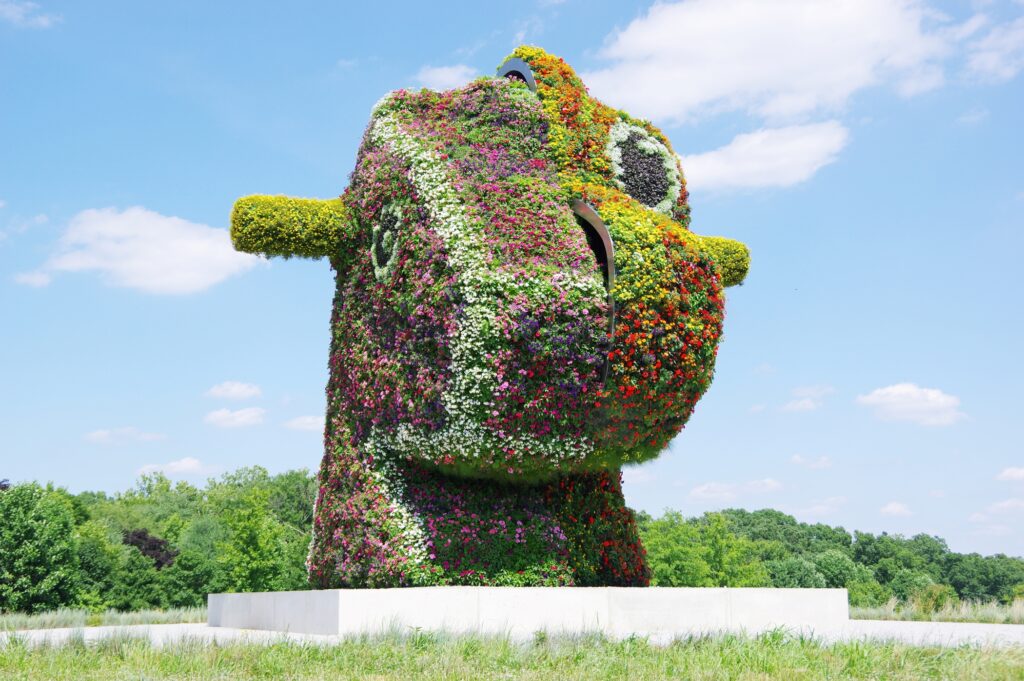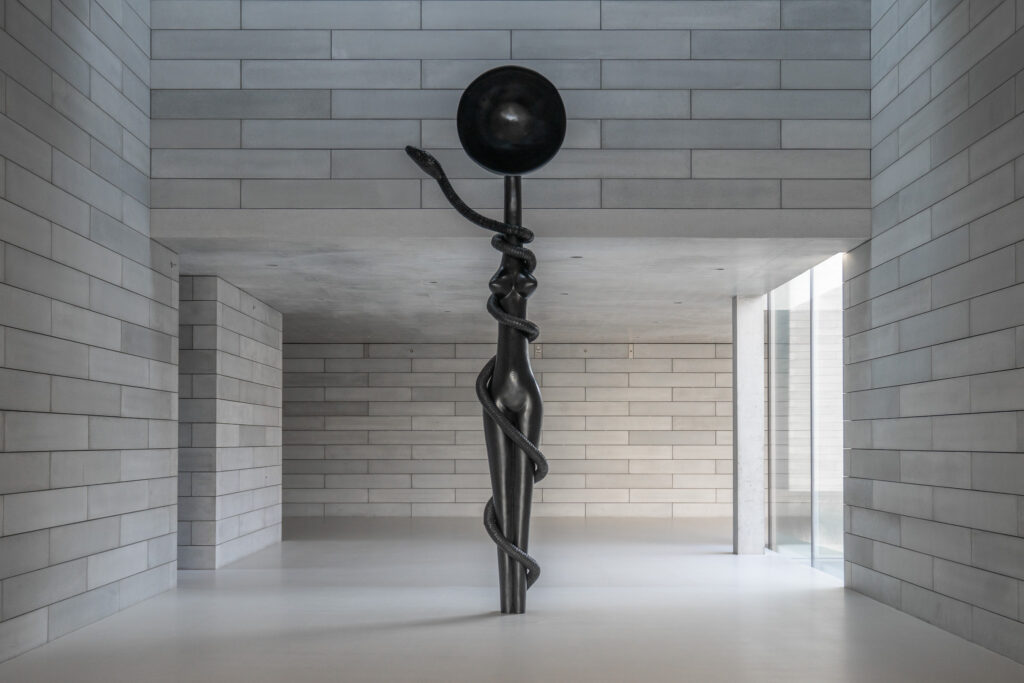Many Are the Happy Marriages Between Art and Space at Maryland’s Lavish Glenstone Museum
For anyone familiar with the currents of contemporary culture, particularly in the nonprofit space, the newly-reopened Glenstone must register as a kind of culmination.

The Pavilions
Glenstone Museum, 12100 Glen Road Potomac, Maryland
Ongoing
There’s a famous story from Pliny the Elder about Cleopatra and Mark Antony at a banquet. As Antony revels in the extravagancies of Cleopatra’s table, she scoffs at his meager conception of luxury, and bets that she can consume more wealth in a single meal than he could possibly match. To win her bet, Cleopatra drops a priceless pearl into a glass of vinegar, waits for it to dissolve, and then swallows the contents of the glass.
Visiting Glenstone Museum, which on March 20 reopened its cathedralic doors, I was reminded of this historical vignette. The museum was founded in 2006 by Emily and Mitchell Rales to “seamlessly integrate art, architecture, and landscape within a single, holistic visitor experience.” Glenstone’s campus is spread across 300 acres in one of the wealthiest zip codes in the country. The Glenstone Foundation had a reported net worth of $4.4 billion in 2022 — meanwhile, the Metropolitan Museum reported $5.6 billion in assets in 2023.
The museum employs 200 people, has 1,300 works in its collection, and comprises 60,000 square feet of state-of-the-art exhibition space between the Gallery — the original exhibition structure — and the LEED certified gold Pavilions, completed in 2018. The interior walls offer no explanatory text, but there is always an obliging — now unionized — museum guide in sight, sporting a custom-designed grey uniform, to answer questions and offer context.
The Pavilions were completed in 2018 to house the foundation’s fast-growing collection, yet the installation of the art is decadently minimalist: each work has enough space to satisfy even the most grandiose visions of the artist. And all this before the museum’s 20th birthday. Glenstone may be the art world’s most formidable debutante.
Indeed, for anyone familiar with the currents of contemporary culture, particularly in the nonprofit space, Glenstone must register as a kind of culmination. Let’s start with the outdoors. With an award-winning organic landscape design, ambitious reforestation project, and a 15,000 square foot environmental center open to the public, its climate and sustainability chops are impressive. Throughout the landscape, works of art by Richard Serra, Alex Da Corte, and Jeff Koons, among others, are integrated to advantage.
Situated nonchalantly in a meadow, Alex Da Corte’s “As Long as the Sun Lasts,” which was originally commissioned by the Met Museum for its Roof Garden, takes on a new poignancy. Viewed from the footpath, a blue-hued Big Bird rotates on his Calder-like perch against an unpeopled backdrop of grass, trees, and sky. The wistful protagonist of Mr. Da Corte’s work has more room to daydream in Glenstone than in his previous homes. It is a charming installation.

If there is a single, presiding monarch of the property, it is Mr. Koons’s “Split Rocker,” situated with pomp and circumstance at the top of the gently sloping hill flanking the path to the Pavilions. Half-pony, half dragon, the 37-foot by 39-foot by 36-foot head splits the difference between sculpture and vertical garden.
Twenty-four thousand annuals – begonias, petunias, marigolds, zinnias, among many others – are replanted on its surface every year, fed and fertilized by a complex irrigation system embedded within its structure, and tended by a professional gardener employed solely for their maintenance.
If Mr. Koons had been at Pliny’s banquet, would Cleopatra have won her bet? “Split Rocker” is the first work a visitor encounters at Glenstone – its placement feels organic yet monumental, and even out of season, it alone is worth the trip.
Inside the Pavilions, new exhibitions showcase works by Simone Leigh, Mr. Da Corte, Jenny Holzer, Charles Ray, and Jaune Quick-to-See Smith. Ms. Leigh’s “Sentinel (Mami Wata)” (2020-21) — an abstracted representation of a West African water spirit — greets you as you descend into Room 1.
An elongated, abstracted female form cast in bronze stands upright at just more than 16 feet, encircled by a thin, black snake whose silhouette truncates the crisp, perpendicular lines of the architecture at a satisfying diagonal, which is echoed by the sculpture’s shadow on the floor.

In this installation of Ms. Leigh’s well-traveled work — originally commissioned for the Prospect New Orleans triennial to replace a Robert E. Lee monument — the rich, burnished surface immediately calls a visitor’s attention to the space’s marvelously conceived light patterns, created indirectly by skylights and the sunlight reflected by the adjacent Water Court.
Many are the happy marriages between art and space at Glenstone. This is far from coincidence: the Raleses and the architect of the Pavilions, Thomas Phifer, designed many of the rooms based on the works that would reside in them on a permanent, or semipermanent, basis. They even solicited input from the artists themselves on the architectural presentation of their work.
Perhaps most strikingly situated is Brice Marden’s “Moss Sutra with the Seasons” (2010-2015), a painting spread almost 40 feet wide across five panels, which resides in a skylit room of its own designed cooperatively with the artist. Four panels are monochrome, and inevitably call to mind Rothko’s monolithic late paintings.
The widest, central panel features layers of meandering lines of color over a limpid ochre background. Like the paintings in the Rothko Chapel, it is difficult to imagine “Moss Sutra” — the sole commission Marden undertook in his lifetime — effectively housed in another space; however, unlike the Rothko Chapel, this process of collaborative design appears to have been congenial.
This give-and-take style of collecting and exhibiting art is one of the most luxurious characteristics of the Glenstone approach. The visual austerity of the Pavilions belies the abundance of highly-credentialed man-hours that went into its construction, whose entire process is detailed in a monograph available in the Glenstone bookstore, situated in the LEED platinum Arrival Hall.
The physical space and the collection it houses are perfectly attuned to our cultural moment, where true lavishness exists in the removal, not addition, of stuff. Although you need a car to get to the museum, the property is designed to obscure the vehicles from sight. Another distraction verboten at Glenstone are children: no one between the age of one and 12 is allowed to visit the grounds or museum spaces.
I’ve heard it said that the 1960s got the artist they deserved in Andy Warhol. The international bien pensant of today has gotten the museum it deserves in Glenstone. Are you a member? Then charge up the Tesla and head to Potomac — Glenstone will not disappoint.

